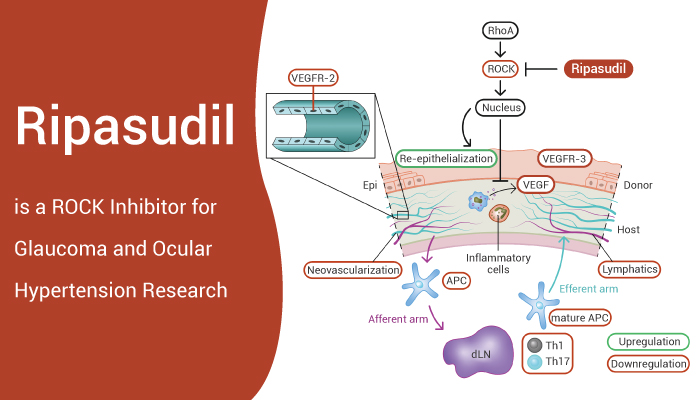Rho kinase (ROCK) is a serine/threonine (Ser/Thr) protein kinase, and is an effector protein of Rho. ROCK regulates multiple signaling pathways and physiological functions, such as neural growth, cytoskeletal rearrangement and cell movement. Besides, ROCK has two isoforms, ROCK-1 and ROCK-2. Moreover, both ROCK-1 and ROCK-2 are widely-expressed in ocular tissues, including the ciliary muscles, trabecular meshwork, iris, and retina, etc. In addition, ROCK-1 and ROCK-2 is tightly relevant with the pathogenesis of glaucoma, ocular hypertension, diabetic retinopathy, and retinal disorders, etc. Therefore, ROCK inhibitors have great potential for treatment of glaucoma and ocular hypertension by reducing intraocular pressure (IOP).
Ripasudil, a potent ROCK inhibitor, can be used for glaucoma and ocular hypertension research.
Ripasudil (K-115) is a specific and orally active inhibitor of ROCK, with IC50s of 19 and 51 nM for ROCK2 and ROCK1, respectively. Furthermore, FDA has approved Ripasudil for the treatment of glaucoma and ocular hypertension.
In vitro, Ripasudil (1 and 10 μM, 30 or 60 min) induces cytoskeletal changes and cell rounding, and reduces actin bundles of cultured trabecular meshwork (TM) cells. Ripasudil (72 h) reactivates cell proliferation and migration in corneal endothelial cells of fuchs endothelial corneal dystrophy (FECD) patients, and also restores endothelial pump and barrier function. In vivo, Ripasudil (0.4%, 50 μL into one eye) reduces intraocular pressure (IOP) in rabbits, as well as in monkeys (0.4%, 20 μL into one eye). In a mouse optic nerve crush (NC) model, Ripasudil (1 mg/kg, p.o., once a day for 7 days) shows a neuroprotective effect on retinal ganglion cells (RGCs), and inhibits the production of ROS. Besides, Ripasudil also inhibits the oxidative stress induced by axonal injury in the NC model mice.
In conclusion, Ripasudil is an orally active ROCK inhibitor for glaucoma and ocular hypertension research.
References:
[1] Kaneko Y, et al. Sci Rep. 2016 Jan 19;6:19640.
[2] Yamamoto K, et al. Invest Ophthalmol Vis Sci. 2014 Oct 2;55(11):7126-36.
[3] Garnock-Jones KP. Drugs. 2014 Dec;74(18):2211-5.
